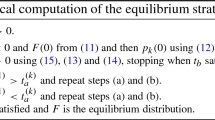Abstract
In the paper an approach to the analysis of business process efficiency is proposed. A method for the estimation of a business process execution time as an important performance measure of business processes efficiency is developed. It represents a combination of queuing networks modelling and simplex algorithm of linear programming. The method allows the calculating of the minimum business processes execution time. A method of optimizing activity of the telecommunication company at a predetermined threshold for the business processes execution time is given. The developed technique was illustrated with an end-to-end business process flow “Request-to-Answer” with initial data close to reality.
The reported study was partially supported by the RFBR, research projects No. 14-07-00090, 15-07-03051, 15-07-03608; Vladimir Potanin Foundation.
Access this chapter
Tax calculation will be finalised at checkout
Purchases are for personal use only
Similar content being viewed by others
References
van der Aalst, W.M.P., Christian, S.: Modeling Business Processes: A Petri Net-oriented Approach, pp. 1–386. The MIT Press, London (2011)
Oracle Crystal Ball. www.oracle.com/us/products/applications/crystalball/crystal-ball-product/overview/index.html. Accessed 01 May 2016
Sidnev, A., Tuominen, J., Krassi, B.: Business process modeling and simulation. Helsinki University of Technology. Industrial Information Technology Laboratory Publications, pp. 1–116 (2005)
ARIS Business Simulator. www.ariscommunity.com/business-process-simulation. Accessed 01 Apr 2016
Baskett, F., Chandy, K.M., Muntz, R.R., Palacios, F.G.: Open, closed, and mixed networks of queues with different classes of customers. J. ACM 22(2), 248–260 (1975)
Ficken, F.A.: The Simplex Method of Linear Programming. Dover Books, New York (2015)
Mantepu, T.M., Solly, M.S.: Modelling and measuring milestones in business process optimization. Probl. Persp. Manage. 12(4), 221–224 (2014)
TeleManagement Forum. Enhanced Telecom Operations (eTOM) The Business Process Framework. www.tmforum.org. Accessed 01 May 2016
Business Process Model and Notation (BPMN). Version 2.0.2: OMG Document Number: formal.2013-12-09. Object Management Group (2013)
Business process framework (eTOM). End-to-end business flows. GB921 Addendum E. R15.0.0., pp. 1–110 (2016)
Moiseeva, S.P., Zakhorolnaya, I.A.: Mathematical model of parallel retrial queueing of multiple requests. Optoelectron. Instrum. Data Process. 47(6), 567–572 (2011)
Nazarov, A.A., Moiseev, A.N.: Distributed system of processing of data of physical experiments. Russ. Phys. J. 57(7), 984–990 (2014)
Bakholdina, M., Gortsev, A.: Joint probability density of the intervals length of modulated semi-synchronous integrated flow of events in conditions of a constant dead time and the flow recurrence conditions. In: Dudin, A., Nazarov, A., Yakupov, R., Gortsev, A. (eds.) ITMM 2014. CCIS, vol. 564, pp. 13–27. Springer, Heidelberg (2015). doi:10.1007/978-3-319-25861-4_2
Samouylov, K.E., Chukarin, A.V., Yarkina, N.V.: Business Processes and Information Technology in the Management of Telecommunications Companies, pp. 1–619. Alpina-Publishers, Randwick (2016)
Author information
Authors and Affiliations
Corresponding author
Editor information
Editors and Affiliations
Rights and permissions
Copyright information
© 2016 Springer International Publishing Switzerland
About this paper
Cite this paper
Samouylov, K., Gaidamaka, Y., Zaripova, E. (2016). Analysis of Business Process Execution Time with Queueing Theory Models. In: Dudin, A., Gortsev, A., Nazarov, A., Yakupov, R. (eds) Information Technologies and Mathematical Modelling - Queueing Theory and Applications. ITMM 2016. Communications in Computer and Information Science, vol 638. Springer, Cham. https://doi.org/10.1007/978-3-319-44615-8_28
Download citation
DOI: https://doi.org/10.1007/978-3-319-44615-8_28
Published:
Publisher Name: Springer, Cham
Print ISBN: 978-3-319-44614-1
Online ISBN: 978-3-319-44615-8
eBook Packages: Computer ScienceComputer Science (R0)




